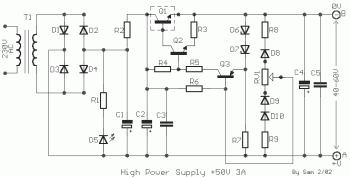Here the +50V / 3A Stabilized and Regulated Power Supply.
schematic diagram:
component parts list:
Note:
It 's a circuit that can give in his exit + 40V until + 60V 3A, with simultaneous stabilization. The materials that use is very simple and will not exist difficulties in the manufacture, is enough you are careful certain points:
Conclusion: ideal output voltage is + 45V until + 60V. In the circuit potensiometer RV1, is used in order to we change the output voltage between + 40V until + 70V, we can however and perhaps it should, him we replace with two constant resistors, when finished the regulation, in the desirable price. The reason is, that with time is presented change of output voltage, up to 3V, with connected potensiometer.
ATTENTION!!! The positive exit correspond in point [ A ] and the exit of 0V in point [ B ], which should not be connected in the ground.
Source:
http://users.otenet.gr/~athsam/power_supply_50V_3A.htm
schematic diagram:
component parts list:
| R1= 10Kohm R2= 1 ohm 5W R3= 3.9 ohms 1W R4= 6.8Kohm 1W R5= 390 ohms 1W R6= 100Kohm 0.5W R7= 1.2Kohm 1W R8= 1.8Kohm 0.5W R9= 3.3Kohm 0.5W RV1= 470 ohms pot. | Q3= BC303 or BC461 D1....4= Bridge 15A D5= LED RED 5mm C1-2-4= 4700uF 100V C3-5= 100nF 250V MKT D6-7= 10V 1W Zener D8-9-10= IN4007 Q1= 2N3055 on heatsink T1= 230Vac / 55V 3A Q2= BD162 or BD243 or BD543 |
Note:
It 's a circuit that can give in his exit + 40V until + 60V 3A, with simultaneous stabilization. The materials that use is very simple and will not exist difficulties in the manufacture, is enough you are careful certain points:
- For output voltages smaller of + 50V until + 40V, the Q1 is hot enough, so that it needs one big heatsink.
- For output voltages bigger of + 50V up to + 70V, the stabilization is not satisfactory.
Conclusion: ideal output voltage is + 45V until + 60V. In the circuit potensiometer RV1, is used in order to we change the output voltage between + 40V until + 70V, we can however and perhaps it should, him we replace with two constant resistors, when finished the regulation, in the desirable price. The reason is, that with time is presented change of output voltage, up to 3V, with connected potensiometer.
ATTENTION!!! The positive exit correspond in point [ A ] and the exit of 0V in point [ B ], which should not be connected in the ground.
Source:
http://users.otenet.gr/~athsam/power_supply_50V_3A.htm

Comments